
* Following the Second World War, the restored French aviation industry worked to develop state of the art jet combat aircraft, including jet bombers. The first operational French jet bomber was the Sud Ouest "Vautour II" -- also built in attack and night-fighter versions -- but aircraft design was moving rapidly at the time, and it was quickly rendered obsolete. To obtain a more effective replacement, they simply built a scaled-up version of the Mirage III fighter, known as the "Mirage IV", with the expectation that it would be soon replaced by a more capable aircraft. In reality, the Mirage IV served to the end of the century. This document provides a history and description of the Vautour II and the Mirage IV.
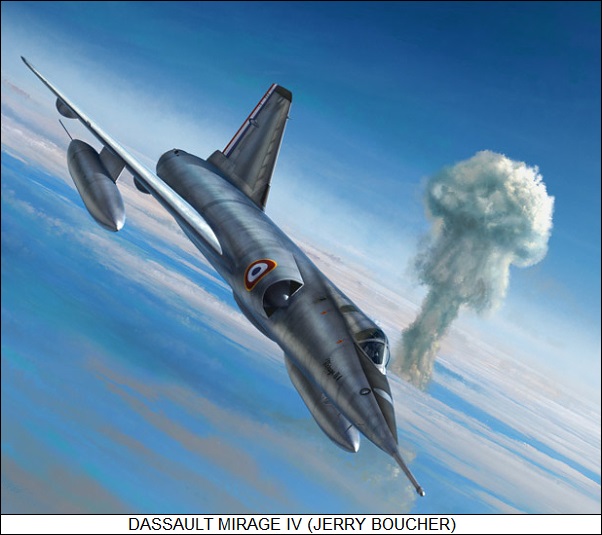
* In the later 1940s, the French Sud Ouest aviation firm began studies for a jet bomber, developing a pair of half-scale demonstrators to evaluate designs. The first, the "SO M1", was a glider, to be released from the back of an airliner, but it is unclear if it ever flew. The second, the "SO M2", was of similar configuration, but was powered by a single Rolls-Royce Derwent centrifugal-flow turbojet with 15.6 kN (1,590 kgp / 3,500 lbf) thrust, with this machine performing its first flight on 13 April 1949. It had a wingspan of 9.08 meters (29 feet 9 inches), a length of 10 meters (32 feet 9 inches), and an empty weight of 3,840 kilograms (8,465 pounds).
The SO M2 was a cigar-shaped aircraft with a bubble canopy and mid-mounted swept wings. It had an unusual landing gear configuration, with main gear in the center fuselage consisting of three wheels in tandem, outriggers retracting into wingtip pods, and a conventional nosewheel. The engine intakes were forward and under the leading edge of the wingroot. This exercise being seen as satisfactory, Sud Ouest went on to build the full-scale aircraft, the "SO 4000 Vautour (Vulture)", of generally similar configuration -- but differing from the SO M2 in scale, as well as in:
It had a wingspan of 17.86 meters (58 feet 7 inches), a length of 19.75 meters (64 feet 9 inches), and an empty weight of 16,850 kilograms (37,155 pounds). The SO 4000 was an absurd-looking contraption, featuring awkward proportions that gave in the appearance of something that a child might have scribbled. Its first flight, on 16 March 1951, was also its last, the project then being abandoned and generally forgotten. It was clearly underpowered and said -- given its looks, very believably -- to be unpleasantly unstable. The SO M2 continued in trials flights for several more years.
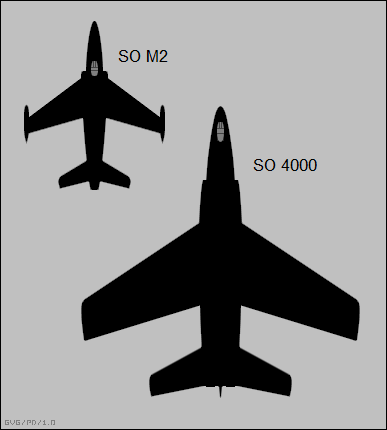
* Sud Ouest wasn't out of the game, however. In June 1951 the French Armee de l'Air (AA) issued a requirement for a multi-role jet combat aircraft that could serve as an attack aircraft, a level bomber, and a night fighter. While the SO 4000 was a complete nonstarter for that requirement, it had given Sud Ouest enough experience to come up with a generally new design, the "SO 4050 Vautour II", which was a swept-wing design with twin wing-mounted SNECMA Atar turbojet engines. Three versions were to be built:
Initial flight of the first prototype was on 16 October 1952, test pilot Jacques Guignard at the controls. It was a two-seater, but not really a prototype of the Vautour IIN, at least not at the time; it had little operational kit, the decision to start with the two-seat configuration being made on the basis that it would be useful in flight testing. Eventually, this prototype would be brought up to Vautour IIN standards.
One prototype each of the Vautour IIA and Vautour IIB was also built, followed by six pre-production machines, consisting of three Vautour IIN, two Vautour IIA, and one Vautour IIB machines. They were rolled out during 1955 and into early 1956. There was some experimentation with fit of alternate powerplants -- British Rolls-Royce Avon and Armstrong-Siddeley Sapphire turbojets -- in the prototypes and pre-production machines, though the Atar would power all production Vautour II aircraft. The first production aircraft, a Vautour IIA, performed its initial flight on 20 April 1956.
BACK_TO_TOP* The Vautour II was a representative combat jet aircraft of the early 1950s, with some configurational similarity to aircraft designed by the Soviet Ilyushin organization. It was of all-metal construction, being made mostly of aircraft aluminum, and had all-swept flight surfaces, the wing being mid-mounted and featuring a 35-degree sweepback. The tailplane originally featured elevators, but was changed after early production to an "all-flying" configuration.
___________________________________________________________________ SUD OUEST VAUTOUR IIA: ___________________________________________________________________ wingspan 15.1 meters 49 feet 6 inches wing area 45.0 sq_meters 484 sq_feet length 15.57 meters 51 feet 1 inches height 4.94 meters 16 feet 3 inches empty weight 10,000 kilograms 22,000 pounds max loaded weight 21,000 kilograms 46,300 pounds maximum speed 1,100 KPH 685 MPH / 595 KT service ceiling 15,200 meters 50,000 feet range 5,400 kilometers 3,375 MI / 2,920 NMI ___________________________________________________________________
The Vautour II was powered by twin SNECMA Atar 101 turbojet engines mounted in underwing pods, with three different Atar subvariants used in the course of production:
The Vautour II featured bicycle-type landing gear, with twin-wheel main gear fore and aft in the fuselage and outriggers extending from the engine pods. Fuel tankage was in the center fuselage, along with a weapons bay. Fuel tanks could be installed in the weapons bay -- they were usually or always fitted to the Vautour IIN night fighter -- and external tanks could be fitted on the underwing pylons.
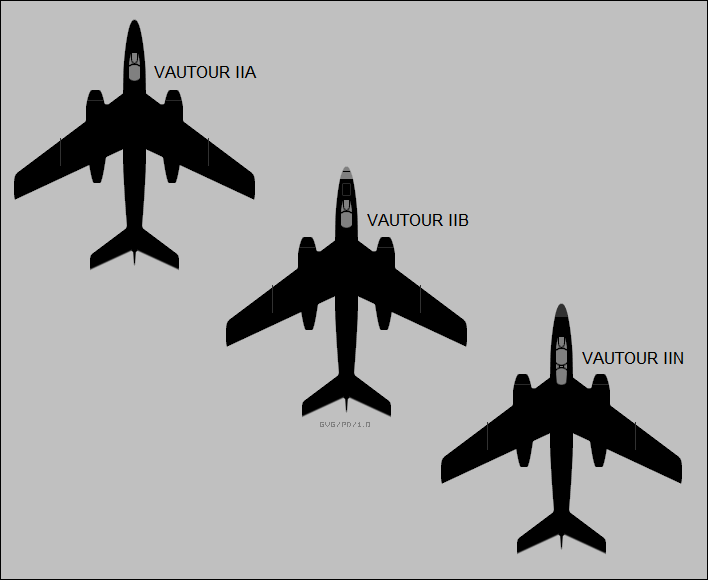
All Vautour II variants had four stores pylons, with the inner wing pylons having a maximum load capacity of 1,250 kilograms (2,755 pounds) each and the outer wing pylons having a maximum load capacity of 500 kilograms (1,100 pounds) each. A typical Vautour IIA or IIB warload would have been six 250-kilogram (550-pound) bombs in the weapons bay, two 1,300-liter (343 US gallon) external tanks, and two 500-kilogram (1,100-pound) bombs on the outer pylons. As far as the individual variants went:
The French government had originally planned to obtain a large fleet of Vautour IIs, but budget cuts intervened, with the decision made to obtain 150 Republic F-48F Thunderstreak fighter-bombers and 50 RF-84F Thunderflash reconnaissance aircraft, the Americans selling them for a bargain price. The US later sold France 88 North American F-100D Super Sabre strike fighters, along with 12 F-100F two-seat conversion trainers.
Aircraft design was moving by leaps and bounds during the 1950s and the Vautour II was quickly rendered obsolete, though it lingered in secondary roles in the AA into the 1970s. Being a fairly large aircraft with an internal bay and the ability to carry hefty payloads, it was often used for trials, one of the most prominent trials being test of the new Cyrano radar in a new pointy nose.
The only export customer for the Vautour II was Israel, which purchased 28 for the Israel Defense Forces / Air Force (IDF/AF), all new-build aircraft, including 17 Vautour IIA attack aircraft, 4 Vautour IIB level bombers, and 7 Vautour IIN night fighters. The Vautour II went into service in 1958 and saw intensive combat through the 1960s, particularly in the Six-Day War of 1967, with a number lost in combat. The Israelis were very pleased with the Vautour II, finding it a capable attack aircraft for daylight operations. Israeli Vautour IIs were replaced by the McDonnell-Douglas A-4 Skyhawk in IDF/AF service in the early 1970s.
Total Vautour II production was as follows:
* The Vautour IIB went into service as part of the French nuclear deterrent force in 1955, but it was clearly inadequate to the role, with the French defense ministry promptly issuing a requirement for a replacement in 1956. Sud Aviation proposed a stretched "Super Vautour" that would have longer range and more powerful engines, but the government was interested in something more advanced.
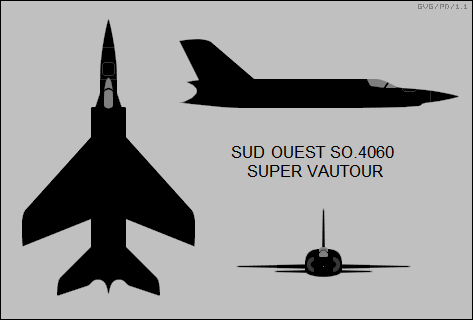
The Dassault firm had begun work on a next-generation jet bomber in 1957. The company envisioned a scaled-up version of the Mirage III fighter, originally focusing on a "Mirage IVC" with twin Pratt & Whitney J75 turbojets, but finally settled on a smaller design, the "Mirage IVA", which was powered by twin Atar turbojets as used on the single-engine Mirage III.
The prototype Mirage IVA first flew on 17 June 1959, and was fitted with twin Atar 09C engines. It exceeded Mach 2 on its 33rd flight, and on 15 September 1960 set a world's record for a 1,000 kilometer (621 mile) closed-circuit flight, with an average speed of 1,820 KPH (1,130.9 MPH / 982.1 KT).
It was followed by three pre-production machines, the first flying on 12 October 1961, after the French had detonated their first nuclear weapon in February 1960. These three aircraft were closer to production spec, with a shorter tailfin. The last of the pre-production machines performed its initial flight on 23 January 1963. It was essentially production specification, with Atar 09K engines providing 46.1 kN (4,700 kgp / 10,400 lbf) dry thrust and 65.7 kN (6,700 kgp / 14,800 lbf) afterburning thrust each.
The Mirage IVA formally entered service with the AA in 1964. A total of 62 production Mirage IVAs was built between December 1963 and November 1966 -- consisting of an initial batch of 50 machines, followed by a second batch of 12. That gave total production of the Mirage IV, including prototypes and evaluation machines, as 66. In 1966, there were nine squadrons on alert, with each squadron maintaining at least one aircraft bombed-up and ready to take off on a moment's notice.
* The Mirage IVA had a configuration very similar to that of the Mirage III fighter, though the bomber was scaled up by 50% in linear dimensions compared to the fighter and weighed about twice as much, and had twin engines instead of one. The Mirage IVA was an all-metal aircraft made mostly of aircraft aluminum alloys. Its engines featured moveable inlet half-cones ("souris / mice") to adjust for different airflow conditions, as well as spring-loaded pressure relief doors set well back from the engine inlet lip to provide additional airflow for take-offs.
Other noticeable differences from the Mirage III were the tandem cockpit for pilot and navigator, plus a much more elaborate landing gear system. The two aircrew got in and out of the aircraft through individual rear-hinged canopies. The pilot had a poor rearward view, while the navigator only had a small window on each side of the cockpit, though he also had a periscope that extended through the floor to provide a downward view. Both sat on Martin Baker Mark 4 ejection seats, license built by Hispano -- they had zero-altitude capability, but required a minimum forward speed for safe parachute deployment -- and the cockpit was climate-conditioned.
The main gear bogeys featured four tires in a two-by-two arrangement, with the main gear retracting from the wing in towards the fuselage. The steerable nose gear had two tires and was long to give the aircraft a nose-up attitude for take-offs; it retracted towards the rear. The landing gear was hydraulically operated.
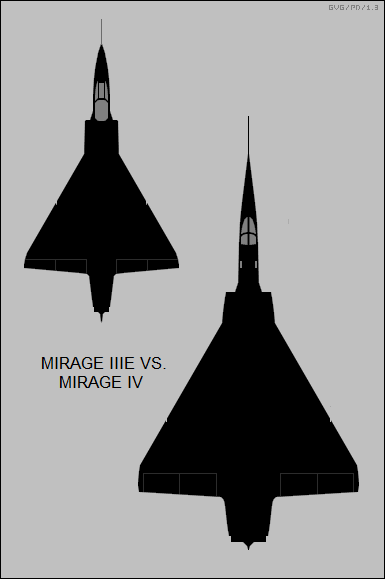
The Mirage IVA's low-mounted wing had the 60 degree sweep of the Mirage III, but featured a thinner thickness-to-chord ratio of 3.8% at the root. This relatively thinner wing was permitted by the aircraft's greater size and was better suited for supersonic flight. There was a small sawcut about two-thirds of the way down the leading edge of each wing to prevent airflow separation over the wingtips. Each wing featured independently controllable side-by-side elevons in the rear and an airbrake on the top forward corner, with all these control surfaces hydraulically operated. The wing contained integral fuel tanks as did the tailfin, and there was a large amount of tankage in the center fuselage as well -- which precluded a bomb bay.
Since delta wings demand a lot of runway for take-off, a loaded Mirage IVA was fitted with rocket-assisted take-off (RATO) boosters, four attached at the rear of each wing. The RATO boosters were discarded after take-off. With RATO boosters and the heavy-duty landing gear, the Mirage IVA was in principle capable of operating from rough airstrips, if they had been treated with ground-hardening chemicals. Since deltas also tend to land "hot", a ribbon-style brake parachute was fitted in a fairing in the base of the tail.
___________________________________________________________________
DASSAULT MIRAGE IVA:
___________________________________________________________________
wingspan:
11.85 meters (38 feet 10.5 inches)
wing area:
78.0 sq_meters (839.61 sq_feet)
length:
23.50 meters (77 feet 1 inch)
height:
5.65 meters (18 feet 6 inches)
empty weight:
14,500 kilograms (32,000 pounds)
max loaded weight:
31,600 kilograms (70,000 pounds)
maximum speed:
2,335 KPH (1,450 MPH / 1,260 KT)
service ceiling:
20,000 meters (65,600 feet)
range:
3,200 kilometers (2,000 MI / 1,740 NMI)
___________________________________________________________________
* Despite the fact that the Mirage IVA had no bomb bay; was crammed full of fuel tanks; and was also generally fitted with twin 2,500-liter (660 US gallon) drop tanks, its range for its assigned mission of penetrating Soviet airspace was still marginal. The French expected to acquire a more formidable bomber later, but eventually gave up on developing a follow-on and settled for a fleet of 12 Boeing KC-135F tankers to give the Mirage IVA a chance to get back home after destroying its target. The Americans were not keen on France acquiring a nuclear force, but the Kennedy Administration cleared the sale anyway. The bomber's long needle nose was actually a midair-refueling probe -- the KC-135Fs were fitted for boom refueling, but they had a refueling basket attached to the end of the boom. There was a retractable spotlight under the nose to assist in midair refueling at night or in foul weather. Incidentally, the basket was all-metal, making it something of a hazard; it was sometimes called "the wrecking ball".
There was a circular radome on the belly of the aircraft, just behind the air intakes, which was initially for a Thomson-CSF DRAA 8A navigation radar. Other avionics included:
An OMERA Robot strike camera was fitted under the nose. There were two stores pylons on each wing, with the inner "wet" pylon normally used for a drop tank and the outer one used for countermeasures gear. A Phillips BOZ 100 chaff-flare pod was usually mounted on the right outer pylon, while a Thomson-CSF Barem automatic jammer pod was mounted on the left.
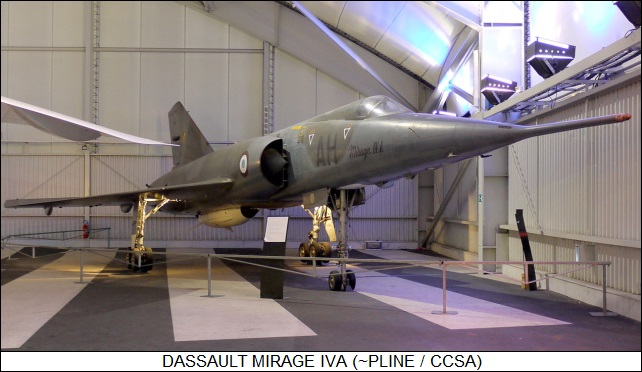
The weapon for which the Mirage IVA was designed, the 60-kiloton AN-22 nuclear bomb, fit into a recess in the fuselage. A ferry tank could also be plugged into the recess. The AN-22 was modified after late 1967 to be parachute-retarded, when it was realized that the Mirage IVA could not expect to penetrate Soviet airspace at high altitude. If the drop tanks were not carried, the Mirage IVA could carry six 1,200-kilogram (2,645-pound) conventional bombs, or four AS-37 Martel anti-radar missiles -- though conventional strike was apparently never more than a secondary mission at best.
BACK_TO_TOP* After the British government canceled the British Aircraft Corporation (BAC) TSR.2 low-level strike aircraft in 1965, a "Mirage IV*" was proposed as a replacement for the British Royal Air Force. The Mirage IV* would have been license-built by BAC and was to have featured the avionics suite developed for the TSR.2, plus a fuselage extension of 61 centimeters (2 feet) and twin Rolls-Royce Spey 25R afterburning low bypass fan jets, providing 93.4 kN (9,525 kgp / 21,000 lbf) thrust each.
The British government didn't bite on the idea, preferring to acquire the American General Dynamics F-111K instead. That didn't work out either, with Britain canceling orders for the F-111K after the program suffered delays and cost escalation. The RAF finally received a modestly modified version of the Royal Navy's Blackburn Buccaneer carrier-based strike aircraft, which turned out to be a fine solution -- but that is another story, discussed elsewhere.
* In the late 1970s, twelve Mirage IVAs were relegated to the strategic reconnaissance mission by replacing the AN-22 bomb with the CT-52 sensor pod, providing a capability along the lines of a "poor man's SR-71 Blackbird". The sensor pod was reconfigurable, a typical configuration being three low-altitude OMERA 35 film cameras, three high-altitude OMERA 36 film cameras, and a Wildt mapping film camera. A SAT Super Cyclone infrared linescan imager could be swapped out for one of the OMERA 36 high-altitude cameras. The reconnaissance variant was designated "Mirage IVR". It appears that changes to the airframe were restricted to wiring and controls for the CT-52 pod.
* In the 1980s, the Mirage IV obtained a new lease on life in the bomber role when a number were rebuilt to carry the ASMP ramjet-powered stand-off missile with a 300-kiloton warhead, instead of the AN-22 free-fall bomb. These aircraft were originally given the designation of "Mirage IVN", where the "N" stood for "Nucleaire" -- but soon were redesignated "Mirage IVP", where "P" stood for "Penetration". This was a substantial upgrade, including:
The Martin-Baker Mark 4 ejection seats were also apparently upgraded to Mark 6 standard, providing true "zero-zero (zero speed, zero altitude)" ejection capability. The upgrade was simple and inexpensive, consisting of fit of a rocket booster kit and minor changes, and other AA machines with Mark 4 seats were generally upgraded to Mark 6 configuration.
The first of two Mirage IVP prototype conversions performed its first flight in 1982. The first of 18 production conversions was delivered to the AA in 1985, with all conversions completed in a few years.
* All Mirage IVP bombers were retired by 1996, with the Mirage 2000 replacing them as the carrier for the ASMP missile. However, five Mirage IVRs were still in service, and three of these made significant contributions to the NATO air campaign against Yugoslavia in the spring of 1999. These machines performed high-altitude, high-speed overflights of Yugoslav territory, observing about 20 targets on a mission.
While the CT-52 pod's cameras were all "wet film" instruments, the film was quickly developed, annotated, digitized, and electronically distributed after return to base, providing NATO commanders with up-to-date imagery intelligence. However, the Mirage IVRs were definitely getting weary, and they were finally withdrawn in June 2005 -- the Mirage IV having served over 40 years with the AA.
* Judging the success of the Mirage IV is difficult, particularly since it saw little active combat service. The aircraft was clearly a compromise type with many limitations, but it did fulfill its assigned mission, and served for long after it was to have been phased out. One judgement is less ambiguous: the Mirage IV was a sleek and elegant machine, and pictures of it taking off with its roaring RATO boosters imply that it was impressive to watch as it climbed off into the sky.
BACK_TO_TOP* This document was originally part of a comprehensive history of all the Mirage delta aircraft. As I obtained new information, that document became unwieldy, and so I broke it down into documents on the Mirage III/5/50, the Mirage 2000, and the Mirage IV. The Mirage IV writeup being brief, I ultimately decided to add the Sud Ouest Vautour II, partly to fill out the document, partly because I couldn't find a better place to discuss the Vautour.
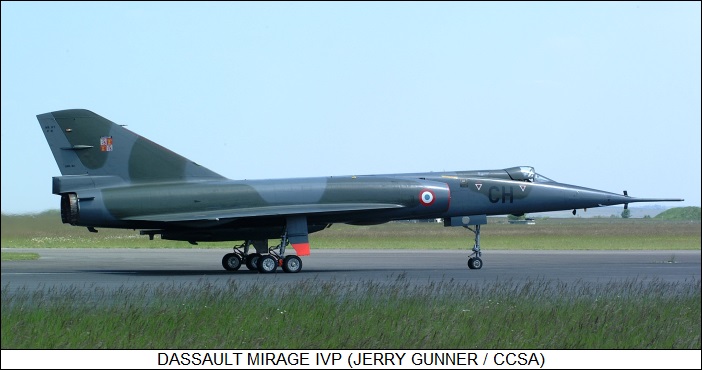
* Sources include:
There's not much data available on the Vautour; I did find an old website from the "WayBak" internet archive with some details, but it was hard to digest. Various operational details for the Mirage IV were obtained from my archive of WORLD AIR POWER JOURNAL magazines.
* Revision history:
v1.0 / 01 apr 00 v1.0.1 / 01 may 02 / Review & polish. v1.1.0 / 01 feb 04 / General enhancement of detail. v1.1.1 / 01 feb 06 / Review & polish. v1.1.2 / 01 may 07 / Review & polish. v1.1.3 / 01 apr 09 / Review & polish. v1.1.4 / 01 oct 10 / Review & polish. v2.0.0 / 01 sep 12 / Added Sud Ouest Vautour II. v2.0.1 / 01 aug 14 / Review & polish. v2.0.2 / 01 jul 16 / Review & polish. v2.0.3 / 01 jun 18 / Review & polish. v2.0.4 / 01 apr 20 / Review & polish. v2.0.5 / 01 feb 22 / Review & polish. v2.0.6 / 01 may 23 / Review & polish. v2.0.7 / 01 may 25 / Review & polish. (+)BACK_TO_TOP
